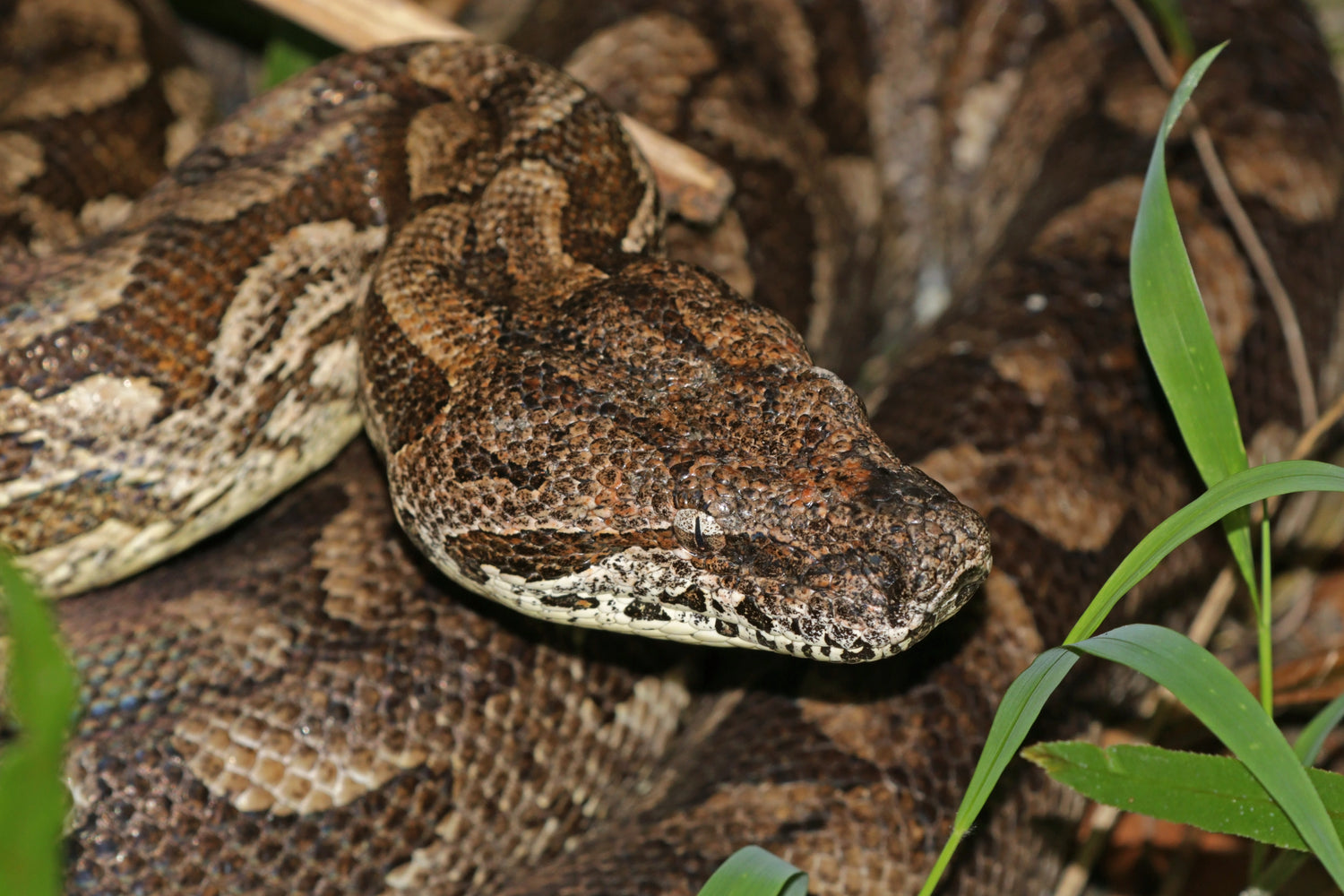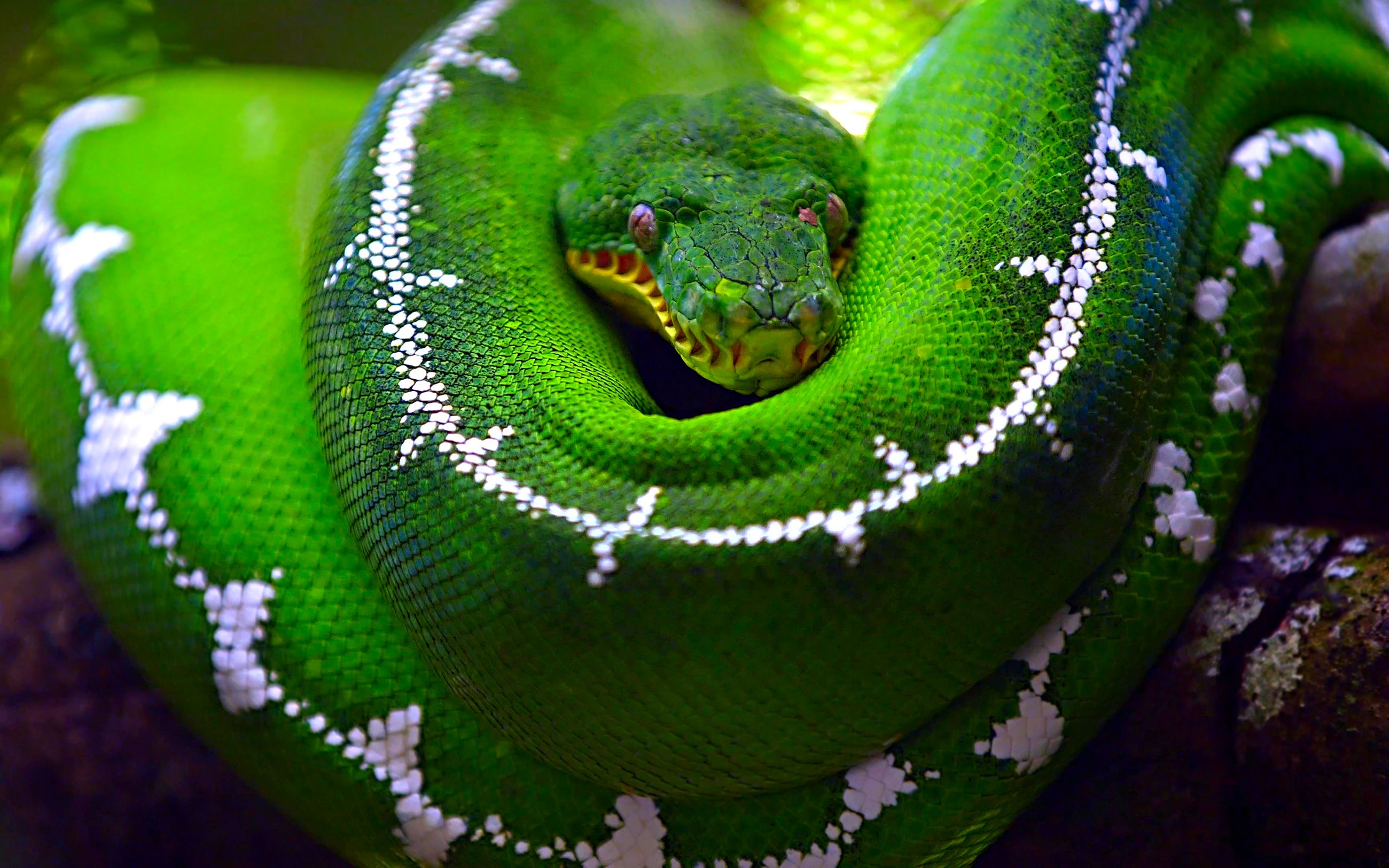Dumeril’s boas (Acrantophis dumerili) are medium to large, terrestrial, crepuscular snakes native to Madagascar. Although this island is best known for its jungles, it also has an area of dry forest in the southwest portion of the island, and that’s where you can find Dumeril’s boas in the wild.
Dumeril’s boas have a mottled pattern designed to resemble the shadows and colors of a forest floor, and are generally some combination of peach, tan, brown, red, and/or gray. There is a significant difference in appearance between males and females — while both have the same colors, pattern, and rectangular head shape, males are more slender and females are thicker. Although the average Dumeril’s boa is around 5-6’ long, females have been known to get as large as 10’.
Dumeril’s boas generally have calm dispositions and tolerate humans well, but their size makes them intermediate-level pet reptiles. With good care, Dumeril’s boas can live more than 20 years.
How much space do Dumeril’s boas need?
Dumeril’s boas’ adult size can vary widely, although it can be predicted based on gender and the size of the boa’s parents. Knowing the expected adult size of your particular snake is important to housing them properly.
As a general rule, the length and width of a snake enclosure should add up to equal or greater than the snake’s expected adult length. For an average Dumeril’s boa, 6’L x 2’W x 2’H is a good starting point. Of course, that’s just the bare minimum. Bigger is always better, and your snake will definitely appreciate it!
Cohabitation (keeping multiple Dumeril’s boas in one enclosure) is not recommended, as keeping them together is likely to cause competition and stress.
Do Dumeril’s boas need UVB?
They seem to be able to survive without it, but it’s still best practice to provide UVB lighting for optimal health and wellbeing. Providing UVB lighting to your snake gives them all of the vitamin D that their body needs, stimulates better appetite and activity, and generally allows them to be healthier than they would be without.
The best UVB bulbs for Dumeril’s boas are:
- Zoo Med Reptisun T5 HO 5.0
- Arcadia Forest 6%
The UVB bulb should be half the length of the enclosure and housed in a reflective fixture like the Arcadia ProT5 or Vivarium Electronics. Place this fixture close to the heat lamp, about 9-12” above the snake’s back while basking if over mesh, and 12-14” above the snake’s back if not.
Make sure that the fixture your UVB bulb is in does not have a clear bulb cover, as UVB wavelengths are blocked by materials like glass and plastic. UVB bulbs decay over time, so don’t forget to replace your bulb every 12 months to maintain good performance.
Lights should be on for 13 hours/day during summer and 11 hours/day during winter to simulate seasonal cycles. This helps regulate the snake’s hormones, which may improve long-term health.
What basking temperatures do Dumeril’s boas need?
Like other reptiles, Dumeril’s boas are ectotherms, which means that they need a temperature gradient in their enclosure to help them regulate their metabolism and stay healthy.
Dumeril’s boas prefer a cool basking temperature of around 88-90°F. On the other side of the enclosure, the temperature should be between 70-75°F. Measure air temperatures in these locations with digital probe thermometers, with the probes placed in the desired areas.
Provide heat for your snake by imitating the sun with a cluster of halogen heat bulbs placed on one side of the enclosure, positioned over a sturdy basking branch or warm hide. Use enough bulbs to evenly heat the snake’s entire body when coiled. Do not use colored bulbs, as these are not as effective.
Heating should be turned off at night.
What humidity levels do Dumeril’s boas need?
Dumeril’s boas prefer moderate ambient humidity levels of 40-60%, as measured by a digital probe hygrometer placed in the middle of the enclosure. It’s also helpful to install a humid hide for your snake somewhere on the cool side of the enclosure, lined with moistened sphagnum moss or substrate. Always having a humid retreat is essential!
To increase humidity, mist the snake’s enclosure with a sprayer. Pouring water into the substrate can also be a helpful way to increase average humidity.
What substrate is good for Dumeril’s boas?
Dumeril’s boas require a thick layer of substrate to cushion their bodies and help maintain healthy humidity levels. As an added perk, it also tends to make the enclosure more attractive.
We recommend the following substrates for Dumeril’s boas:
- Zoo Med Reptisand
- Exo Terra Desert Sand
- Zilla Jungle Mix
You can also make your own substrate with a mix of 60% clean topsoil and 40% play sand.
For best results, layer clean, chemical-free leaf litter on top of the substrate. Dumeril’s boas love leaf litter!
Substrate should be at least 3” deep and completely replaced every 3-4 months. Remove poop and urates immediately along with contaminated substrate. As a heads up, Dumeril’s boas tend to drink a lot of water, which means that they urinate a lot, too. Be prepared to replace soiled substrate frequently.
What décor can you use in a Dumeril’s boa terrarium?
It’s terribly boring for a snake to be stuck in an enclosure with nothing in it except substrate, a hide, and a water bowl. It doesn’t matter how big the enclosure is if you don’t put things in it for your pet to use and interact with.
Here are some decor ideas for enriching your boa’s environment:
Whatever you choose to use, make sure that the snake has plenty of cover to hide in so it can feel secure in its environment.
What do Dumeril’s boas eat?
Like other snakes, Dumeril’s boas are carnivores, which means that they need to eat whole animal prey in order to get the nutrition that they need. Here is a rough feeding schedule based on snake age:
- Hatchlings and juveniles (<3′): Every 7-10 days
- Subadults (longer than 3′): Every 2-3 weeks
- Adults (no longer growing): Every 3-4 weeks
Prey items should be around 10% of your snake’s weight and/or no bigger than 1.5x the snake at its widest point. Feeder options include mice, rats, hamsters, gerbils, young guinea pigs, young rabbits, chicks, and quail. Variety is the key to a balanced diet!
Although live prey can be used, it’s safest and most humane to use frozen instead. Prey should be thawed in a plastic bag in warm water to approximately 100°F before offering with a pair of soft-tipped tweezers.
Supplements
Snakes can survive without vitamin or mineral supplements, but occasionally using them can help prevent nutritional deficiencies and optimize your pet’s health. We recommend Repashy Calcium Plus LoD.
Water
Make sure to provide a tub or bowl of water large enough to accommodate the snake’s entire body. Keep the water in this tub clean at all times, and scrub with animal-safe disinfectant once a week.
Do Dumeril’s boas like to be handled?
Few reptiles actually “like” to be held, but Dumeril’s boas are known for a docile nature and generally tolerate human interaction well. That being said, there are still some basic rules for handling snakes:
Wait at least 2 weeks before attempting to handle a new boa. Babies and juveniles tend to be more nervous and defensive than adults. Be gentle, and pick up the snake from below rather than from above. Support as much of its body as possible, and NEVER pick up a snake by its tail! Keep handling sessions brief at first, and always end them on a positive note, with the snake acting calm.
*This care sheet contains only very basic information. Although it’s a good introduction, please do further research with high-quality sources to obtain additional information on caring for this species. Here are some other great sources:
"File:Dumeril's Madagascar ground boa (Acrantophis dumerili) male head Isalo.jpg" by Charles J Sharp is licensed under CC BY-SA 4.0




Leave a comment
This site is protected by hCaptcha and the hCaptcha Privacy Policy and Terms of Service apply.